

|
West Coast Swing: An Appreciation

Photo from: here
Welcome to my personal appreciation of West Coast Swing Dance as art.
My primary audience here is those who may have heard of Swing dancing, who may be intriqued to consider the amazing West Coast Swing variant of Swing, and are curious enough to: (1) Look into what makes this modern kind of partner dancing so special and (2) Look at a representative collection of world-class West Coast Swing dances.
As an added bonus, I'll also delve into the deeper esthetic aspect of West Coast Swing ("WCS" for short) for those who might already be familiar with it and, as was the case for me, got interested in the wider context of dance in general as an artistic medium and as a language of bodily motion
This no-frills web page is chock-full of photolinks to videos of WCS dances. Click the photo to see the video. With a focus on WCS Followers, the links comprise my careful selection of favorites collected over many years of studying world-class champion dances on the Internet. I also include some Introductory sections highlighting aspects of WCS. Enjoy...
To kick things off, here's a summary video that covers how wide the spectrum of WCS is (note the variety of international venues in this great montage--WCS is growing world-wide). (~5m):
There are many Lesson-1 videos for West Coast Swing on the Internet. Their quality varies widely and some are poor. But here's a nice beginning breakdown of the West Coast Swing basic 6-count pattern. I particulary like this breakdown because it clearly distinguishes the "tripple step" from the "anchor step" in the explanation of the fundamental parts of every WCS count pattern. The pink and blue circles mentioned are conceptual training-wheel aids to learning and not to be taken too literally. (~7m)
West Coast Swing is growing world-wide but large areas of the world have no convenient access to capable WCS instructors. If you don't live conveniently near a ballroom studio where WCS is taught and socially danced (I haven't for many years), you can try the Youtube instructional videos. Or a good way at home to learn and practice patterns is using instructional DVDs. The set I bought some years ago and have direct experience with was the superb 3-DVD set that could be purchased from Ben Morris's web site. The set had professional production values featuring world-class dancers Ben Morris and Melissa Rutz. I continue to use the set as an encyclopedia of WCS patterns. Unfortunately, as of this writing, that set seems to be unavailable. You may be able to find the first disk of that excellent set as a paid video on Ben Morris's Youtube channel.
Consistent with my obsessive video mode of WCS appreciation, I like using video (DVD or online) as a learning method. For example, while viewing a DVD you and your partner can stand in front of the TV and slowly work through new patterns/techniques as the instructors cover and demonstrate them by freezing position at a verbal count. With a little ingenuity (Duct Tape!), you can wear the DVD remote control like a necklace and easily pause video at those points and replay as needed. It's a great way to learn/practice patterns if WCS instruction at a ballroom/studio is not conveniently near you. There may be some free or paid Youtube videos that offer that professional level of instructional sophistication. In lieu of DVDs and Youtube instruction videos, some online instructional venues have recently popped up that use video conferencing apps such as Zoom or Skype. Another option is to travel to one of the nearest WCS competition events which almost always have outstanding instructional workshops. Most of the WCS Champion dancers and professional instructors have web sites and/or Facebook pages. Those will steer you to instruction venues that are online, brick-and-mortar, or DVD. As usual, try Internet searching.
If you've never danced WCS, just to give you the flavor, as it were, of "stock" WCS patterns, here's a summary list of the names of the count patterns covered as Basics in WCS instruction:
Unfortunately, there's variation in the naming of the patterns across the WCS instructional world. That is often due to the different teaching approaches used to ease entry into what might initially look like a bewildering complexity of patterns. All WCS patterns derive from the primitive "step, step, tripple-step" sequence. The "tripple-step" is done rapidly within two music beats (or two "counts"). If we actually sound out each part of the tripple step sequence, it goes "3 and 4"--with a separate step executed on each sounded "3", "and", "4". The tripple-step is thus three quicker steps done within two beats of the music. So that sequence of step, step, tripple-step is performed in sync to FOUR beats of the music. Despite what that instructor said in that previous video (ie, saying there is "no basic pattern" in WCS), since my first lesson, I've always thought of that four-beat step sequence as the foot-motion that is the foundation "pattern" of all other WCS patterns. You'll also hear the term "anchor-step" used to more clearly distinguish a tripple-step that punctuates the end of a count pattern. For example, the simplest 6-count pattern of all is: step, step, tripple-step, anchor-step where the middle tripple step is done in place and the ending anchor-step is just another (special) tripple-step. In that simplest WCS pattern of all, that middle tripple-step is the "something happens" so nicely described in that previous video. In the short list of 6 count basic patterns above each pattern is named to describe what the "something that happens" is during the middle of the pattern (eg, "Sugar Push"). As the video shows, much of the action and expressive "variation" happens in that middle of the count pattern with the anchor-step serving as the hinge upon which the sequential flow of count patterns swing--to use a pun.
So each count-pattern is constructed in such a way that the end of any one can smoothly become the beginning of another (transitioned on the "anchor-step"). Thus a dance is a sequence of those patterns smoothly hooked together by the two dancers. The "Lead" role in the patterns is traditionally male with the "Follower" role traditionally female--a legacy from a long tradition of ballroom dance forms. Of course, nothing dictates that gender assignment. In WCS this role aspect gets very interesting because either the Lead or the Follower can initiate a transition to the next pattern with the other partner challenged to smoothly flow into the transition to the signaled next pattern. The patterns are all initiated and carried out by practiced--and amazingly subtle--hand, touch, and body signalling. In action to music these signals can be sent and recognized in less than 250 milliseconds. Despite WCS being called an open dance, to allow for the signalling, it must nonetheless have a constant "connection" between the partners. That connection is most often seen in the simple holding of one set of opposite hands while the other arms are available and "expressively" free. Hence the dance is described as "open".
The first time I understood how WCS patterns are crafted and connected, the analogy with written language captured my interest. Written languages use sentences made up of a Subject and a Predicate with a period at the end to signal the end of a packaged thought. By analogy, the WCS count-patterns are like sentences with the anchor step being a kind of period at the end. This analogy is rough because the WCS "sentences" can hook together by sharing the anchor step. The basic sentence construction is step-step-[do-pattern]-anchor-step. The main expressive action within the sentence is the Lead-signaled "do-pattern" portion of the "sentence". In the joint effort of the dance, that expressive dimension is complemented by the Lead's expressive dimension of orchestrating the sequence of sentences. Thus multiple layers of artistic expression operate simultaneously.
To summarize: In the domain of moving to the beat of music, WCS is like a language of bodily motion whereby you and your partner can jointly connect together the dance pattern "sentences" to express an amazingly rich variety of art on many simultaneous levels. Once you "get" the expressive power of it's construction logic on the dance floor, it becomes profoundly fun and addictive. It's relatively easy to get started dancing WCS with a small set of the basic patterns. That said, like any skill, with continued engagement you graduate to higher levels of proficiency at crafting more sophisticated levels of artistic expression.
There is a balanced division of labor in WCS. By construction of the "language" mechanics, the roles are not identical. The analogy is a bit like the Lead is the arranging conductor of the artwork and the Follower takes on half the artistic work by harmonizing with and enriching the initiated arrangement. This doesn't preclude delightful breakout surprises where the Follower initiates pattern changes. In fact, as you'll see, that's when things get really interesting. Nonetheless, the Lead typically has more say in the sequence of patterns while the Follower's mission, should the challenge be accepted, is to contribute more to the innovative styling that the jointly-created artwork expresses as a whole. At its most synergistic, both the stimulus and the response are calculated on the fly. At the highest skill levels, hopefully we can see beyond the mere exhilarating fun on the dance floor to view what's going on as high art.
I count about 30 basic West Coast Swing patterns in the "vocabulary" of its dance "language". They are the foundational, most often seen, patterns with names like: sugar push, left side pass, passing inside turn, and reverse whip. That basic set includes 6-count and 8-count patterns. A "count" is a beat of the music. Through studio instruction venues, and generally on the dance floor, the champion dancers gradually acquire a much larger vocabulary with many advanced patterns beyond 8 counts. So, beyond the basic patterns taught in dance studios world-wide, there are perhaps twice that many being honed in the WCS community--especially in the champion-level competition circuit. Also, champion dancers embellish within patterns adding their own improvised variations to hone their own unique style. We'll get to that.
The dance "language" vocabulary makes for a huge potential for variation of expression and affords an amazingly sophisticated pallet for improvisation--more sophisticated than Lindy Hop and the "robotic" ballroom dances. WCS evolved from Lindy Hop with a couple of extremely important but seemingly innocuous changes to the most basic pattern. Those changes also channeled the WCS dance form into a rectangular region of the floor called the "slot". Unlike the circular rotation and the characteristic hop-on-the-beat seen in most of the Lindy Hop patterns, WCS gives the dance partners a characteristicly more smooth "rubber-band" connected appearance because the stock patterns most often confine the dancers to the slot. More on that here (~10m):
For context, here is some excellent Lindy Hop. Notice the characteristic hop on the beat and also that the dance usually goes in a circle. (~2m).

https://youtu.be/ryGGfOr-KgA?t=19
Arising from dance traditions that assigned the driving role to the male "Lead", something about the subtle evolution of WCS from Lindy Hop also opened the door for more initiative from the "Follower". That has led to what I think of as a new level of improvisation being turned loose. The changes also opened WCS to a wider spectrum of slow to fast music. When defending WCS against devoted Lindy Hoppers, my analogy is: Lindy Hop has the sophistication of Checkers while West Coast Swing has the sophistication of Chess. Many of the champion WCS dancers you will see in this collection started as Lindy Hoppers and graduated to the improvisational sophistication afforded by the greater expressive potential in WCS. For a contrast with that previous Lindy Hop here is some classic, outstanding WCS (~2m each):
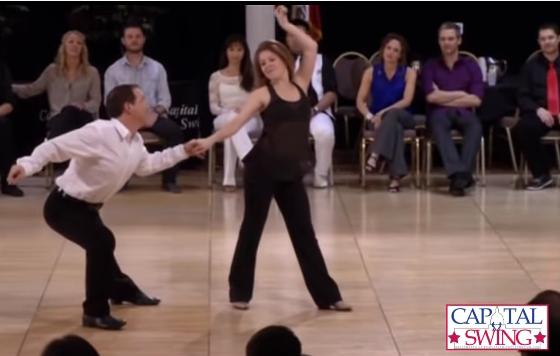
https://youtu.be/l0oYR_0CXUg?t=46
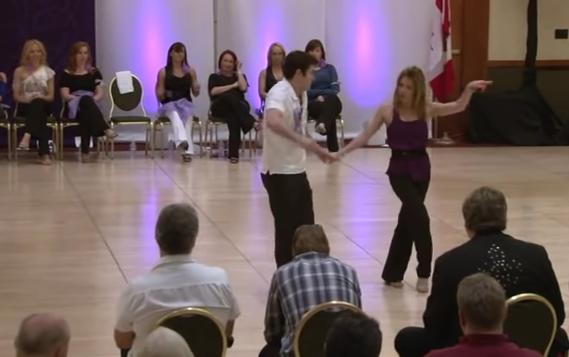
https://youtu.be/sjyo5VvpTxU?t=142
As another contrast, it would be somewhat difficult to dance Lindy Hop to the music which West Coast Swing accomodates quite handily (to use a pun) in the following dance. (~2m)
WCS can certainly go at the speed of fast Lindy Hop. In the following two competition dances, the team of Matt Auclair and Torri Zzaoui [Smith] exhibit fast WCS improvisational speed. (~2m & ~2m):
Here are three more outstanding examples of WCS speed featuring Matt Auclair as Lead again. First is Matt leading Melina Ramirez-Stuart in a Grand National win. (~2m):
Matt leading Debbie Figueroa in a 1st Place Jack & Jill win at Dallas Dance 2003. (~2m):
Matt more recently leading Patty Vo in a 1st Place Jack & Jill win at Desert City Swing 2018. (~2m):
Shaking off the long, more staid aura of Ballroom Dance, this dance form is infused with an amazing flourishing of expression as the Lead and Followers play off each other in a kind of heightened esthetic adventure that has seemed to evolve with the wider spectrum of popular music. As with many areas of culture, the advent of Youtube added gas to the WCS fire in the early 2000's and helped initiate what I consider its distinctive current era.
In my favorite competition format--called "Jack & Jill"--the randomly-paired dancers improvise to create the dance on the fly to randomly-selected music. With practice they develop a "feel" for each pattern and, at the champion level, they exhibit a high level of artistic virtuosity in how they match pattern changes to the music/lyrics. At peak performance--in the "zone" as it were--they use the dance almost like a motion-gestured commentary on the music and lyrics. Each dance is a joint creative expression that is integrated with the music/lyrics using the WCS language.
Of course many other partner dance forms allow for expressive improvisation and music interpretation. But I'll make the case here that not only does WCS offer a wider latitude for it but also that such latitude has undergone--in conjunction with the advent of Youtube video availability--an artistic shift outward, toward exposing the expressive improvisation beyond the dancer's enjoyment and more to the viewing audience. Thus, there are multiple levels of artistic creativity running simultaneously in a WCS dance. That challenges the creativity of the dance-artists even more to create a richer joint work of art. In keeping with that outward audience focus aspect, you'll see that almost all competitions show the dancers with their peer dancer pool of competitors visible to us, the viewing audience. That was a brilliant invention whereby we, the real audience, get to see the peer competitors with their often exagerated reactions to the skillful events within each dance. They serve to cue our attention to those events with genuine enthusiasm that is infectuous. One audience sees the other audience while both see the art work. As I say: it's a brilliant audience configuration that enhances the artistic experience beyond what's going on solely between the two dancers. When it comes to video capture of the competition dances, WCS devotees can appreciate WCS-aware switched-angle camera work. But the the judges' view should nonetheless dominate to keep the energy of this double-audience factor in play.
Improvisation occurs with how the WCS stock patterns are hooked together into a sequence to express an interpretation of the music/lyrics. Improvisation occurs with surprising, very noticeable variations within a stock pattern. The following excerpt (from a champions-level competition at Liberty Swing) shows an outstanding example of improvisation within a standard WCS inside turn pattern enhanced with precision styling. Watch (@6:32) how Melissa Rutz starts by flowing into it with one turn per beat. But then she does something surprising for those used to the standard patterns. In time with the music, and for an artistic effect, she stretches the pattern timing and spins down to a half turn per beat, and then smoothly plays out of the pattern in a quarter turn per beat. That's just one pattern enhancement. As dancers graduate in WCS that kind of enhancement is simply called "styling". (~30s):
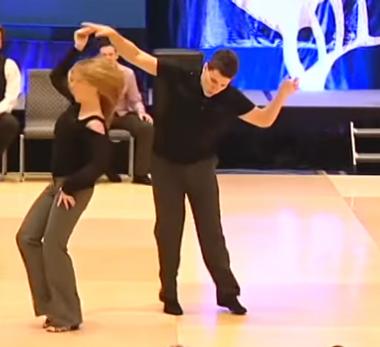
https://youtu.be/6iYHgNppSw4?t=385
In Jack and Jill competition, partners don't know when such styling might be coming and have to learn to quickly style off of the other's styling. The best dancers most often pack their artworks with a very calculated and often astonishing density of such precision styling. As with most of the dances selected here, the rich, intra-pattern styling goes by so smoothly and quickly that it seems to be an integral part of the whole. But the constructed artistry hides the highly skilled precision within. If anything, that aspect is half of the appreciation I'm celebrating here. If you get as addicted to this amazing art form as much as I am, you tune-in to such parts after taking in the whole.
I mentioned that the open nature of the WCS dance partner configuration enables the dancers to use their free arm for expressive styling. Here's a stunning example of this. In the following dance excerpt, savor Melissa Rutz's wonderful styling as she uses her free arm to "conduct" the music. Very classy. It's also a great example of how, as a stylistic ornament, a precision-timed pause can punctuate the dance with a dramatic interpretation of the music. (Benji Schwimmer and Melissa Rutz at Sincity 2014). The full dance is simply golden but unfortunately was copyright-blocked on Youtube because of the music: Frank Sinatra's "Fly Me to the Moon (In Other Words)". Hence, I've included a short video excerpt. The original complete Youtube video has been blocked and unblocked a couple of times. First try the following photolink to see if the full video has come back alive on Youtube and pay close attention at about 1:24:
Otherwise click the following player and pay close attention at about 0:18 in this excerpt. (~30s):
Improvisation also occurs with the invention of new patterns that can mesh into the "sentence" sequences. Thus, the language itself can evolve in fascinating ways. This has been a major factor in what hooked my intellectual interest in this amazing art form. In the years I've been studying this WCS motion "language", I've seen how the vocabulary creatively evolves. This may seem trivial but it's the linguistic aspect of this coupled with how that aspect evolves that I have been looking at carefully. The following dance presents an example. In it world-class WCS Follower, Victoria Henk, initiates a pattern I hadn't seen before (starting @ 2:21). I'll call it here the Spin Capture. Devotees of the "WCS language" live for surprising, creative linguistic extensions like this. (~15s):

https://youtu.be/jVB7KbU39cs?t=135
With this device we see Victoria performing a unique Follower-initiated pattern which, to me, symbolically celebrates the female romantically capturing the male. What a thoroughly delightful invention! It can be thought of as a styling end to a common WCS pattern. In that dance she pulled it off as a surprise with Ben meshing seamlessly. Here's Victoria using a Spin Capture on Maxime Zzaoui. You can see Maxime initially show some confusion when Victoria's otherwise unsurprising spin progresses into this surprising pattern completion. But he quickly jumps into the flow of the transition with his own delightful improvised styling. (~30s):
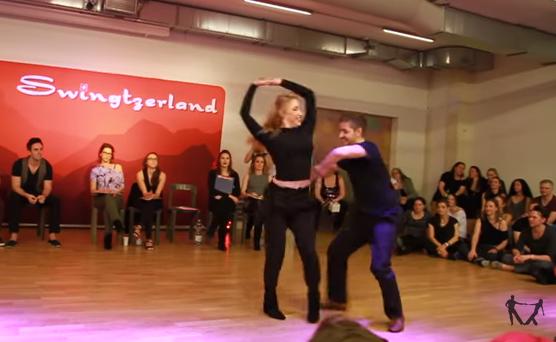
https://youtu.be/8g5jE0tyD9I?t=156
The pattern appears now and then. Here's Torri Zzaoui [Smith] applying a Spin Capture to Ben Morris and he instantly responds with his characteristic humorous improvisation. The dancer pool knows the WCS language intimately and their vocal reactions are in response to beautiful variations that they instantly recognize as uniquely creative linguistic "turns of phrase". In these various dance selections, if you hear bursts of audience reaction for no apparent reason, you probably don't know the WCS "language" which the dancers creatively modified in some surprising and very delightful way. (~15s):

https://youtu.be/v0x-D8LyfEM?t=102
Maybe it's just relevance to our modern culture, but to me the connected and team-improvisational nature of WCS puts it on a whole other modern level, both artistically and linguistically. Since a WCS dance is a chain-link of patterns the basic rule is not to break the chain in some ugly way--by missed signals and certainly not by the ugliest of breaks: a tumbling crash to the floor. And disasters happen to the best. In the following dance two improvised patterns go haywire in the improvisational attempt to accentuate the music--ironically interpreting "falling" in the lyrics. But, nonetheless, notice how Ben and Torri recover and show skill in using dance gestures and patterns to reinforce the lyrics. As opposed to other modern ballroom dance forms doesn't this hearken back more to the kind of gesture language in Hula? (~45s):
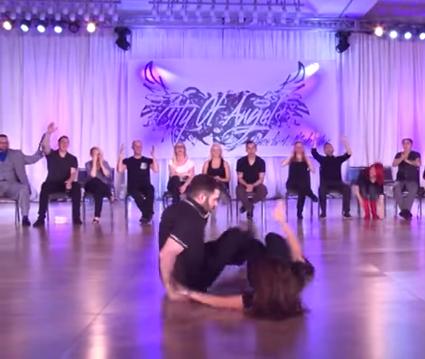
https://youtu.be/PuAUJbPWnkY?t=85
It is a hallmark of WCS that there is an emphasis on integrating dance with song lyrics. In the following, with Lead Semion Ovsiannikov, watch how skillfully world-class dancer Victoria Henk styles some patterns to insert her own dance interpretations of the lyrics (eg, "watch the rising sun", "hit the road", and those great double/half timing changes to the lyrics "I'm driving fast now" and "go slow"). The song is common in WCS but this artistic work offers a very fresh champion-level Jack & Jill improvisational interpretation. This is outstanding interpretive synchronization with lyrics. (~2m)
Here Brad Whelen and Victoria Henk play with integration of dance and lyrics creating a kind of fun WCS dramatization of a song. All using styled-WCS dance patterns:
I mentioned before that the unique structure of WCS enables dance partners to jointly connect together the WCS dance pattern "sentences" to express an amazingly rich variety of art on many simultaneous levels. Delving deeper into what might be called the esthetic technology of that, I'll go through how I like to think of those semantic (ie, intentional) levels.
The semantics at Level One is the Lead selecting (and signalling to the Follower) a count pattern from the current pallet of WCS patterns that the Lead and the Follower know. Governing this selection is an artistic desire to express with motion-gesture something that accentuates the joyful theme of the accompanying music.
The semantics at the next Level Two is to create a surprise styling variation on the selected well-known standard pattern (or even to surprise with the creation of a new pattern on-the-fly). Of course the selected pattern may simply be the unstyled basic pattern as learned--a degree of minimal styling practiced by beginners.
The semantics at Level Three is to synchronize Levels One and Two with an interpretive emphasis of the meaning of the theme and lyrics (if present) in the accompanying music.
The semantics at the next Level Four is what I like to think of as the level of team synergy where both partners have mastered execution of the "technicals" to the degree that the ongoing creativity becomes smoothly self-amplifying. It's where you start to see awesome peak performance by partners who are mutually "in the zone" operating at all the levels simultaneously. They're jamming. And it's an artistic level to relish if you're executing it or if you're carefully watching and understanding it. This is where it really gets addictive to do or to watch.
Focusing in on that highest proficiency level, there's a certain threshold of technical skill which, when reached, you don't have to prove yourself anymore. On demand you can check all the technical boxes while ornamenting your artistic creation with style. The effort is still a huge challenge but you can afford to restrain from being overly baroque and concentrate instead on working toward what I might call a unique stylistic perfection. It's that intangible, personal projection that artists struggle to convey when they have full command of technique. That's where I look to see what speaks to me most when enjoying WCS as a watchable art form as performed by world-class artists.
When climbing the levels of proficiency, I think styling is the main challenge where the less-skilled dances are somewhat barren of finely-tuned styling, confined as they are to simply executing a sequence of the stock WCS patterns. At full speed, the challenge isn't so much the packing in of an abundance of ornamentation; it's the master craftsmanship of a calculated insertion of ornaments where their composition and the precision timing of their insertion achieves, in the thematic context of the music/lyrics, a maximum of stylistic and emotive effect. I've come to think of that peak artistic skill level as the "Zen" of West Coast Swing.
There is nothing new to seeing dance as a "language of bodily movement". That aspect of dance may have pre-dated the invention of spoken-sentence language. The Hula of the Pacific islanders comes to mind as a tradition of musical dance used in the expression of stories. Watch the following powerful performance of Kahiko Hula. It uses accompanying chant, traditional instruments, dance posture, and hand gesture to symbolically reinforce the story being dance-dramatized. Stay with this one; it's simply stunning (~5m):
I find this much richer than the Americanized hula that arose as filtered through modern music and culture (ie, Auana Hula). Kahiko Hula is just more compelling. At least as is evident in this stunning example, its primitive rawness may speak more deeply through narrative to the universal in the human condition. Its message can be strangely assertive in the face of the symbolic power of natural and human forces. It is actually conducive to the theme of this commentary that we don't know the spoken language of the narrative chanting because that absence serves to heighten our awareness of the dance language itself. Watch it again and think of the voices as musical instruments accompanying the ipu drums. In doing so it's hard to escape the sense of an elevated stature of some universal message. If you get that sense then the language of the dance itself is successfully speaking to you even though you don't know the story. Every posture and hand gesture has a meaning either as semantically-driven symbolic or as dramatic punctuation.
There's a drama that's being communicated. She starts with a searching posture and a vocalized call of entreaty. There's almost the sense of a foreboding of anticipated struggle. That heightens the context for the story. Then with dramatic introduction of drum beats and chant, the dance/story begins. This kind of Hula has ancient roots. It can have gestures for reaching upward to the great powers of nature, for the rolling of huge ocean waves, for the tracing of mountain shapes, for the falling of rain, for the stealth of a crawling beast, for the grotesque caricature of threatening enemies, and much more. It is dramatic and certainly more powerful for those who know the native spoken language (in addition to the semaphores in the dance patterns). Of course there are more sensuous messages for the Hula such as in the Tahitian and modern auana variants you'll see often as tourists in Hawaii.
Taking the linguistic theme a bit further, here's an experiment of integrating actual sign language into dance "body language". It's on vimeo, so you have to click the video to play it after clicking this link (~4m):
In that dance we can see some signs of the modern Shuffle dance craze. In yet another way that the Internet has poured gas on the experimental mixing of artistic forms, a music genre that came to be called "ElectroSwing" became hot to the point of viral on Youtube. It is music made to order for Shuffle dance. Though it has nothing to do with West Coast Swing, here are two examples of Shuffle Dance to ElectroSwing music. Unlike WCS, there is little room for intrepretive integration with lyrics and such goofy lyrics as in the second example might challenge that anyway. But it looks great for cardio. Note that the second example is a shuffle montage that, in a previous incarnation, garnered over 250 million views proving that Youtube videos of dance do offer the potential for monetization. Maybe WCS could benefit from this in some way? More on that later. (~5m each):
When it comes to WCS improvisation here's a representative winning dance that is one of my all-time favorites. These champions spice their dance with obvious fun and push themselves to the limit of their skill with judges watching very closely. (~2m):
A superb example of WCS, that dance includes many aspects that set it above most other less-imaginative dances limited to stock WCS patterns. In that dance, to the delight of everyone, Melissa challenges Ben with a stunning transition break in which she throws him two alien patterns from a Samba-like dance form--almost in a parody of them. She makes it extra humorous by her accentuated execution. It's a fun little mini-revolution of the Follower. (~10s):

https://youtu.be/M3cgDv1BxNQ?t=44
You can see that Ben is jolted (as is everyone watching who knows the language). While his hand is out inviting re-connection after her connection break, there's a short interlude of wonderful suspense for us and a stunned Ben. But then after seeing her alien pattern display, Ben instantly switches into a response with humorous mimicry of Melissa's initiatives--to the further delight of everyone. But, wait, it gets much better. To add more suspense along the tight-rope of risk, coming out of a complex of multiple inside turns, Melissa drops to the floor into a split that shockingly fails. (~30s):
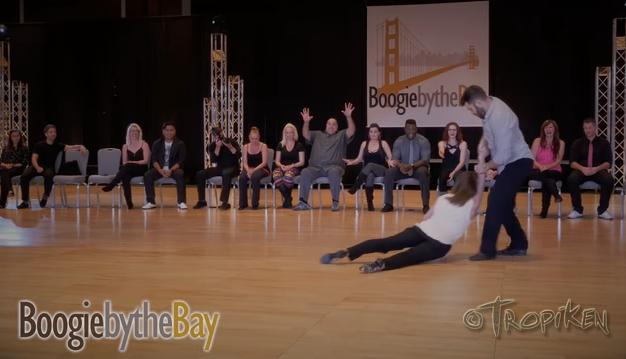
https://youtu.be/M3cgDv1BxNQ?t=94
In retrospect it may be evident from Melissa's earlier slide ride in the dance, that her floor/shoe interface may have gotten extra slippery. Obviously things went too far for her graceful recovery from the split. It looks like it took Ben less than 200 milliseconds to see her predicament. John Lindo in the dancer pool throws up his hands in expectation of shocking disaster--he could see the Melissa's face. We then see this dance team's world-class improvisational skill lift victory out of the jaws of disaster--and for added drama, at the very end of the dance. This is like a winning hail-Mary throw at the very end of a basket ball game. The crowd goes wild because they just saw a team's stunning, on-the-fly creation of a new WCS pattern--under national-competition pressure. One viewer humorously called the pattern the "Caveman Drag".
As was seen in that dance, with the flexibility of WCS, champion-level dancers often delight audiences with little stylistyc allusions to other dance forms. In the following improvised J&J dance Kyle Redd & Torri Zzaoui [Smith] throw in some Shag (at the start of the 2nd song @ 2:14), followed by fast Jack & Jill improvisation at its very best. (~2m):
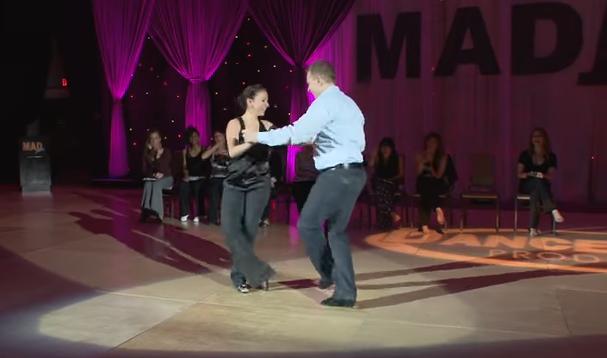
https://youtu.be/Novs7yBpq1g?t=125
Like West Coast Swing, Shag Swing is an interesting derivative of Lindy Hop swing dance. Originating in the Carolina's (Myrtle Beach) where there was a Scottish contingent in the early years of settlement. To see how Swing dance has evolved by incorporating other dance patterns, first see this example of Cape Breton Scottish Step Dance that was popular in the early Carolina's. (~30s):
You'll see that pattern influence in the following dance. With its very challenging emphasis on leg/foot work, here is one of the best choreographed examples of Shag Swing that I've ever seen (Brenner Goree and Autumn Jones at the 2014 Grand Nationals). (~3m):
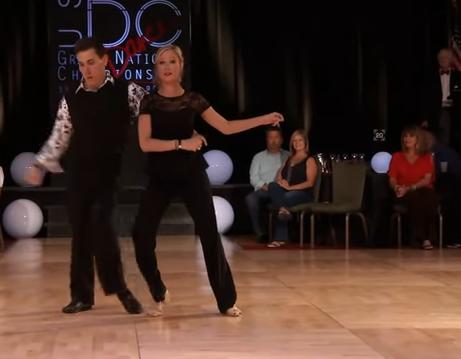
https://youtu.be/8l5pczCZw04?t=11
Speaking of Shag, here is Brenner Goree again leading Torri Zzaoui wherein they launch into some nice Shag:
Partner dancing has always offered an intimate means of communication between the partners. Perhaps the extreme dance form for that intimacy is the Tango. Tango is indeed richly improvisational. But the improvisation within the closed connection is greatly constrained to variations in the Lead's step and the Follower's variation of response step. Within such a very narrow range, most of the action is expressed in a very limited vocabulary of leg motions. Freely expressive body posture and arm gesturing are largely prevented by the tight upper body connection so characteristic of this dance. Here's some authentic Tango. (~1m):
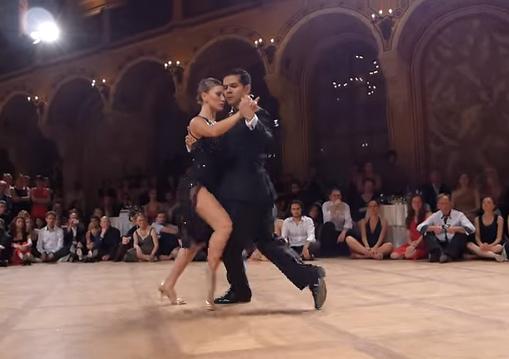
https://youtu.be/sxm3Xyutc1s?t=15
It's not a dance with a rich potential for an outward esthetic aim toward the audience. It's almost all for communication between the dancers. It's not so much to be watched as to be experienced in the connection on the dance floor. Tango also has a more restricted range of music that works with the dance. A great emphasis is placed on leg movements as having a kind of mystique--even erotic--meaning to them. A huge romantic mystique has grown to surround this dance/music combination. With such testimonials of "tango rapture", "tango took me on a tour of my inner landscape", and "tango is the dance that elevates the common hug to an art form" we are clearly in the realm of a mystique. This aspect gives it a huge pretext for psychological projection to the point that it has a cult following such that devotees will fly to Argentina just to dance "authentic" Tango. Here's an advocate's description of this cult philosophy of Tango. About a minute will give you the idea. (~1m):

https://youtu.be/K2tUL3G1zTM?t=309
Be that as it may, like most ballroom dance forms, to me Tango seems stiff and robotic compared to WCS. My analogy here is that WCS is more like brush painting in bright colors on canvas whereas Tango is like drawing with an Etch-a-Sketch, each partner turning one of the two knobs. Sorry, couldn't resist that. Metaphors be with us. But seriously, compare that previous Tango with this WCS masterpiece by Benji Schwimmer and Brandi Guild at Desert City Swing 2016. (~2m):
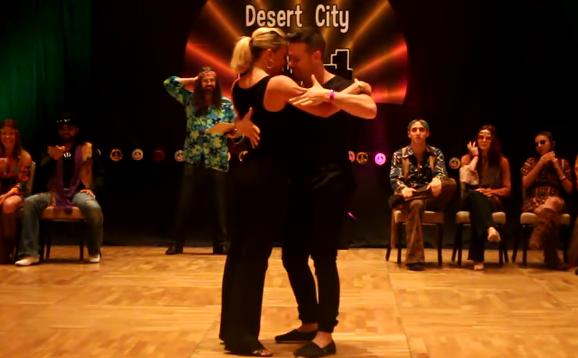
https://youtu.be/qBvvwCeHyWs?t=38
That dance is a tapestry of WCS patterns richly embellished with added styling. Benji masterfully sets the tone for that dance with a gesture of taking ownership of Brandi's body. And then, in reply, Brandi asserts the beginning of the beautiful balance of sensuality in this dance by slowing her first outside turn by two counts for a dramatic styling effect. To me, it's almost like her gesture is saying "Hold on. Have you earned that ownership?" It's a standout departure from a stock WCS pattern which Benji takes in stride by smoothly sending Brandi into a continued set of turns. And this is just the first 15 seconds into the dance. From that point onward we know we'll be witness to the crafting of an outstanding work of art with a quality level of unique tension that is sustained throughout. And they mesh it so well to the theme of the music.
The artistic range of West Coast Swing is amazing. And these two artists show it beautifully with that interpretation which takes West Coast Swing into a sensuous realm that I think is suggestive of where the Tango lives. To me, the potential shown here is superior to the closed-connection Tango because the romantic "conversation" in WCS is achieved via an open connection allowing more expressive power to both partners. Rather than the Tango's intensely intimate communication that is between the partners, WCS becomes more of a joint creation that is not only for mutual partner enjoyment but is aimed at audience enjoyment of the artistry as well.
To illustrate the vast difference that the Lead can have in the "conducting" of a joint WCS dance creation as enhanced by the interpretive styling of both partners, compare that previous dance with the interpretive span in the following dance to the very same music. Here Brandi Guild is the Follower again but this time with the brilliantly creative Ben Morris as Lead in this superb interpretation to that music. (~3m):
WCS has the range and isn't beneath doing a hilarious parody of the Tango mystique. (~2.5m):
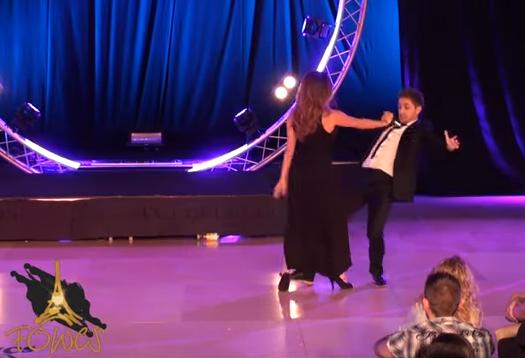
https://youtu.be/d2qRZ6KIlAU?t=5
Not that Tango dancers can't swing. (~2m):
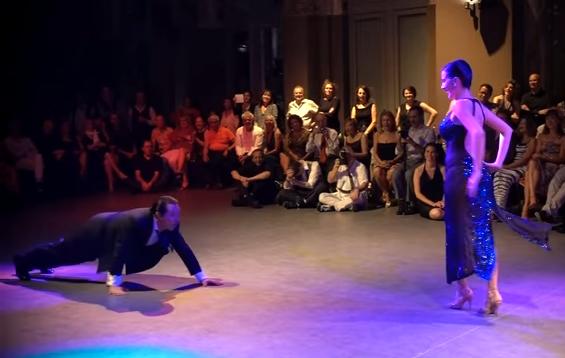
https://youtu.be/C8YTNUgSz98?t=19
To further emphasize the range of WCS and provide a stark contrast to that previous raucous swing, here's a much smoother look with a strong romantic esthetic. A delightful example of Jack & Jill interpretive improvisation--Benji Schwimmer and Melissa Rutz at their improvisational best. The term "masterpiece" for me keeps coming up when either Benji Schwimmer is Lead or Melissa Rutz is Follower. There often seems to be a magical synergy when they're a team. (~2m):
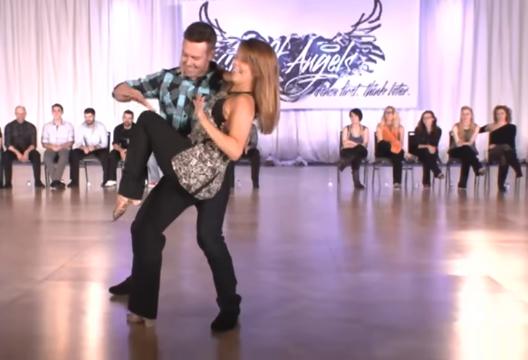
https://youtu.be/iP6-cGJUNKo?t=3
Here is the incomparable Benji Schimmer again, this time with Victoria Henk in another example of slow WCS exhibiting that amazing combination of rich styling integrated so well in a thrilling interpretation of the music's romantic theme and lyrics. Note the skill this team shows in essentially providing their own beat to this unique music. I know I'm over using the term, but despite maybe a couple of awkward transitions, to me this is another WCS interpretive masterpiece. Wow... (~4m):
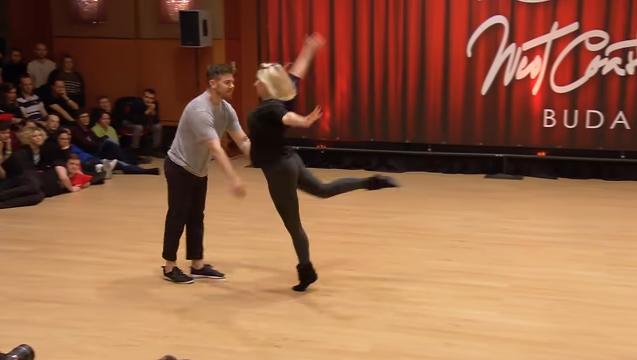
https://youtu.be/AxBvf3BgFs0?t=25
On a quest for the best while studying hundreds of Internet videos, the incomparable Melissa Rutz keeps dancing into the spotlight. Here is Jason Wayne leading Melissa on a romantic theme. 4th Place? I don't get that. (~2m):

https://youtu.be/Z5IR-R6qAHY?t=8
Michael Kielbasa leading Lemery Rollins, 2016 Capital Swing Champion J&J, 1st place:
Ben Morris leading Victoria Henk at Wild Wild Westie 2016 Pro Show Improv. Two of the best at interpretive synchronization with lyrics. Outstanding team armwork at 1:34. (~2m):
Jordan Frisbee leading the highly flexible Victoria Henk:

https://youtu.be/SJehTlKp9zE?t=36
Parker Dearborn leading Victoria Henk:
Jordan Frisbee leading Nicole Clonch:

https://youtu.be/frgyvPGlWpw?t=108
Jordan Frisbee leading Torri Zzaoui:
Kyle Redd leading Torri Zzaoui at SinCity 2014. Dig this classy atire, including Torri in stelettos:
Kyle Redd leading Torri Zzaoui at Liberty Swing 2016:
Maxence Martin leading Melissa Rutz at Capital Swing:
Benji Schwimmer leading Torri Zzaoui [Smith] in US Open Showcase 2013 Win:
And to complete this series of superb WCS as it interprets romantic themes. Here's my current premium selection of the fabulous and classy married team of Maxime and Torri Zzaoui in some outstanding dances offering brilliant styling and interpretive integration with romantic lyrics and a delightful spice of added humor. They're simply wonderful. When these two get together it's hard to exclude any of their dances from my selection... Note that Torri is featured often in this commentary sometimes under her maiden name, Torri Smith. (~2m each):
Given that WCS pattern transitions can be initiated by either partner (usually the Lead), in the hands of some dancers, it can go haywire and descend into competition within the dance. In the following Jack & Jill improvisational dance the dancers drift into a bit of that power struggle and then, I think recognizing it on the fly, run with that aspect and creatively play with it to the point where Benji escalates the power struggle and puts a head-lock on Melissa, actually driving her to the floor--putting her in her place as it were. Adding styling to her recovery, Melissa then strikes a motherly pose of scolding Benji to which he brilliantly responds in a boisterous parody of the unruly child. Just hilarious. All beautifully in time to the music. This delightful level of on-the-fly improvisation is highly skilled artistry using WCS patterns. There is a jointly-constructed semantic goal aimed both in fun with each other and at the audience in the creation of the artwork. If it was an ice sculpture it would have melted and never be seen again. Except this dynamic bit of artistic fun was captured on video. (~1m):
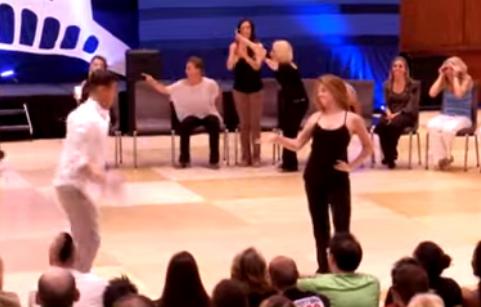
https://youtu.be/ua81OF4AqMo?t=98
Here's a rare audience video of Benji and Melissa in the Jack & Jill Preliminary Qualifier at Boogie By the Bay 2019. (~2m):
Some of the best improvisational West Coast Swing that I've ever seen was live at Seattle Easter Swing 2016 with Benji and Melissa in a Champions Jack & Jill All-Skate. They went all-stops-out. To a fast beat, there was an astonishing speed of smooth improvisational coupling. It was wild perfection. There is no public recording that I know of. To an audience, individual dances are often lost in the dance-floor crowd of an All-Skate. I was in the audience 15 feet away from this dance at the edge of the dance floor and was so mesmerized that I didn't think of running the camera. When the music stopped, those of us in the audience near me exchanged glances in a state of jaw-dropping awe at what we had just seen.
In some of the dance videos here you'll hear the infamous "Rutz", "Rutz" chant when Melissa Rutz entered the competition floor. The first time I heard it I thought she was being boo'd, which would be unconscionable. The ambiguity of it is what is annoying. Here's an example (~30s):

https://youtu.be/CoGX2xxa3dc?t=6
In 2018 you still hear vestiges of that infamous "Rutz" chant as in the following dance. Regardless of that, this dance is extra special. (~2m):
Ubiquitous smart phones often grace Youtube with alternate video views of the same dance. Since I love to study amazing WCS technique, here is a much better audience view of that wonderful dance. There is subtlety in this dance. It may not seem so, but to me this is sophisticated WCS led by the very cool and commanding Parker Dearborn. Parker should wear white shoes whenever he dances--he talks with his feet. To me this dance gets extra good when the piano takes over @1:15. (~2m):
I just love that dance. The apparent simplicity hides a complexity of skill. To me, throughout the dance there's a delightful delicacy that they style so appropriately to that particular music. What grabs me most is the intricate precision in the timing of patterns and footwork sustaining an interpretive integration with the piano.
When it comes to WCS as a watchable performance art form, Melissa's art is ornamented with surprises of crafted style delivered with precision and spiced with that indescribable flair of joyful ebullience. And Parker's skill is so well matched to bring it out. Parker is so cool. To me he dances a smooth, commanding Lead that has a unique style of restraint that is a hallmark of what I call understated elegance.
The song in that last dance was "My Baby Just Cares For Me" by Nina Simone. Because I love to compare different artistic WCS interpretive stylings to the same songs, here is another great Jack & Jill interpetation of that song (Benji Schwimmer leading Victoria Henk at BbB 2019--thanks to Kathleen Sun for this outstanding close-in camera work that makes it easier to study highly-skilled technique). (~2m):
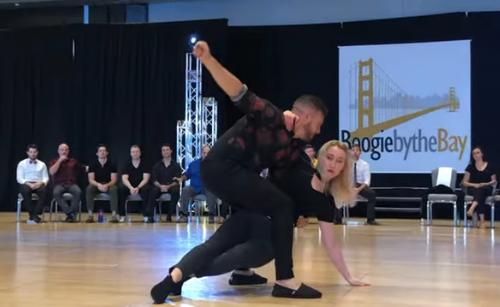
https://youtu.be/YdfKCLjYsnA?t=77
Of course, a highly selective focus on style reflects my personal esthetic opinion. Judging mainly at champion skill level, the margin of comparison based on technical skill is narrow at that rarefied altitude. So I hasten to add that my selection within this commentary is in no way meant to diminish the amazing skill and unique styling of a host of other WCS Champion dancers that I've studied and sadly neglected in this already large collection.
Here's another of my all-time favorite WCS dances. Yes, with Parker and Melissa. To me, it just has a mystique of smooth, classy quality--the artistry of WCS as I like it most:
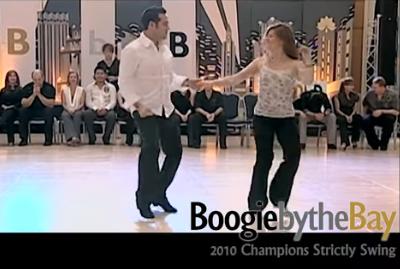
https://youtu.be/m-rr2KpTNUo?t=8
Speaking of Parker wearing white shoes and talking with his feet, look at these three excellent examples. I love Parker's relaxed command. This team is so cool!
And when it comes to Parker and Melissa, I cannot leave out this awesome tribute to one of my all-time favorite movies: "La La Land". What a delight, showing the potential applicability of WCS to the movies. When have you ever seen tap integrated with WCS? Priceless! (~4.5m):
Despite the refreshing way that the emancipation of the Follower has progressed, from my perspective, some of the other evolution I've seen seems to have drifted a bit too far from precision footwork. The distinct anchor step has been undergoing something of a vanishing act. Watch any of the previous strict-judged dances closely and you'll see a contrast with the following two dances in how the technical "look" of these dances exhibits a more precise WCS footwork. There has been a drift toward a more ballet look probably because it's so hard to maintain footwork precision in the heat of the now richer interpretive and competitive improvisation. Here is an "old-school" example of what might be called a "look" of precision footwork (Seattle Easter Swing 2004; the low-resolution video technology was primitive back then). Watch especially the Lead, Buddy Schwimmer (~2m):
For comparison (using the very same song) here is a more recent competition dance with some champion dancers who I think distinctly exhibit that kind of footwork. Kyle Redd and Sarah Vann Drake in a first-place Jack&Jill win at Liberty Swing. (~2m):
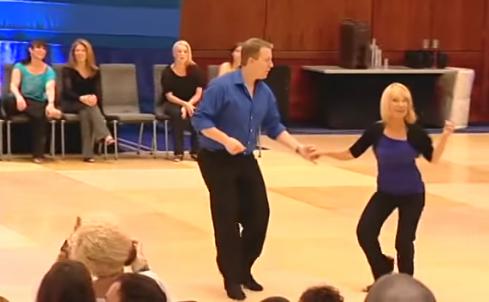
https://youtu.be/6iYHgNppSw4?t=919
Of all the songs it seems that James Cotton's "How Long Can A Fool Go Wrong" became something of a WCS standard. To that song here's Robert Royston leading Melissa Rutz in a Grand National 1st-Place Win exhibiting a very fun mix of stylized humor while checking the technical boxes. Good footwork here as well. (~2m):
That had a touch of WCS somewhat making fun of itself, to the delight of everyone (and the judges).
Another fine interpretation to that song. Parker Dearborn and Torri Zzaoui [Smith]. (~2m):
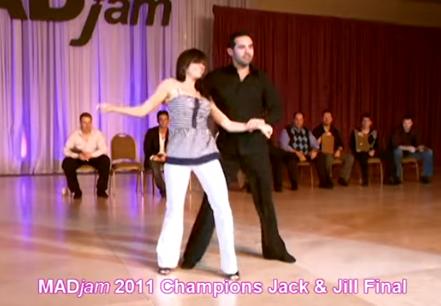
https://youtu.be/cfgP9JM3iQ4?t=121
And as though you couldn't get enough of that song here's a video with insets of three simultaneous, synchronized dances to that song (in a tribute to Kyle and Sarah's Grand National win). This video is also a showcase of how skilled these champions are. After all those years Kyle and Sarah re-dance in sync to their many-years-previous winning dance and, in a separate inset, Kyle and Benji do the same. Benji amazingly dances Sarah's Follower role to Kyle's Lead. I heard a rumor that Benji had about an hour to learn this routine (as Follower no less)--he was a last-minute stand-in at that venue because Sarah had a leg injury (~3m):
Speaking of champion-level skill, here Ben Morris joins the team of Jakub Jakoubek and Emeline Rochefeuille, a champion WCS team from Europe--a real test of their skills. (~3m):
Hailing from Czech Republic and France, when Jakub and Emeline team up they seem to have their own unique improv WCS style. Sometimes stretching WCS past some limits, many standard WCS patterns appear pleasingly bent with surprising timing variations. (~3m):
I think I've also noticed that there has occasionally been a pushing of the erotic envelop in some racey dances, perhaps over the line of decorous propriety. How about strip-tease WCS?
Or, here is Benji Schwimmer with Jennifer Deluca. (Also, in their 2nd song, watch for Jennifer's moonwalk styling). (~4m):
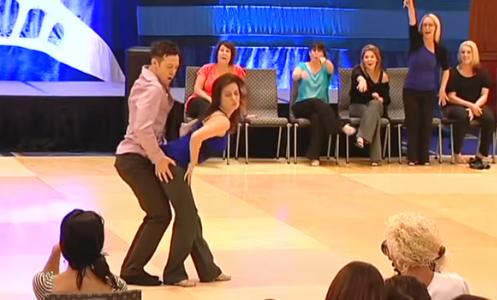
https://youtu.be/6iYHgNppSw4?t=429
Having been blocked on Youtube for awhile, that entire Liberty Swing competition in one large video was restored. It is remarkable because of it's absolutely unhinged all-skate finale at the end. That very fun finale has to be seen to be believed, cued here @28:45. If you haven't experienced WCS on the social dance floor yet, this will give you a clue about how fun this social dance can get. (~3m):
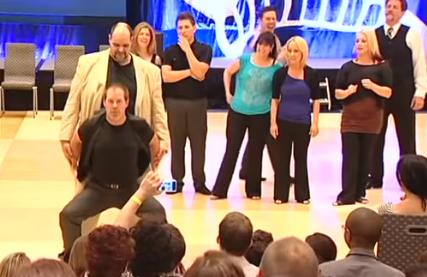
https://youtu.be/6iYHgNppSw4?t=1720
Aided by the Internet, WCS is spreading world-wide. Here is Jordan Frisbee leading Torri Zzaoui in a Jack & Jill improvisation at 2019 D-Townswing (Dusseldorf, Germany). Note the professional, switched-angle camera work. Look how nonchalant Jordan's smooth and masterful command of this dance is. And Torri's matched styling is excellent. (~2m)
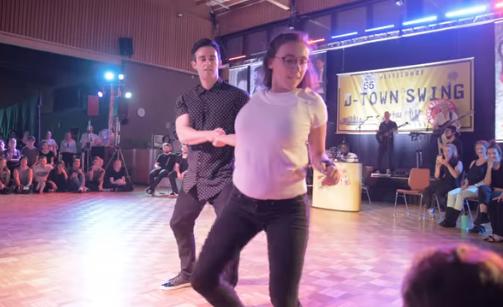
https://youtu.be/0GECUdRsvio?t=142
I wish more venues covered their action like Dusseldorf did in that competition with professionally-coordinated switching of multiple camera angles. It shows they're aware of the outward audience dimension of this art form. But it does require some WCS awareness to best control the timing of the camera angle switches. Some of the angle switches in that dance were not in good timing with the WCS interpretation going on.
To that same song compare the following J&J improvisation with Torri Zzaoui as follower again this time led by Sean McKeever:
To that same song yet again compare the following great improvisation with Maxime Zzaoui leading Melissa Rutz taking 2nd place Champions J&J at the Oct 2019 BbB. (~3.5m):
So much WCS and so little time. I often study improvisational Jack & Jill WCS competions at the lower Allstar level. Here's an especially good Allstar J&J performance in Dusseldorf. And I also love the graphic on Joao's T-shirt ;-) (~3.5m):
WCS has several divisions of competition at the national championship level. In the Showcase division the dancers choreograph their dance to chosen music and pick their partners and costumes for a different kind of creative excellence. Showcase has more freedom with less restrictions on lifts and air time. I much prefer the surprises and extreme skill in the true Jack and Jill improvisation but after watching very many of the winning Showcase dances, this is my all-time favorite so far. Benji Schwimmer and Torri Zzaoui [Smith] are just outstanding in this masterpiece of WCS choreography (US Open 2011). (~3.5m):
This team is awesome. Their joint precision choreography, rich styling on a backbone of WCS patterns, high-energy interpretive musical synchronization, and amazing speed make the following Showcase dance an exemplar of West Coast Swing at it's artistic very best. (~3m):
That's my favorite performance of that amazing Showcase dance. It is a re-performance of their 2012 US-Open winning dance. I actually prefer this repeat over the original winning performance--there's something about the extra-vibrant energy in this rendition.
Some 7 years later--at the recent 2019 D-Townswing, Dusseldorf--they danced in a Jack&Jill competition to that same music. They pulled it together very well as a kind of homage with a couple of their previous Showcase lifts; but Torri nixed any more lifts toward the end. With lifts like those, this is high risk Jack and Jill. The audience knew and appreciated the significance of the risk this team took in this performance. (~3m):
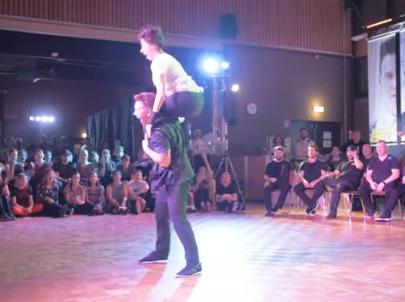
https://youtu.be/D1BoBdcwh58?t=198
In the context of the Showcase Division, though the following dance doesn't feature WCS patterns, it's a dramatic and stunning first place win in the Cabaret division at the Open Swing Dance Competition. In that Caberet division there you can dance anything except Swing which is an enriching idea because of the contrast it can give. In any case, you have to see this to believe it!
WCS has a kind of characteristic whereby the Lead constructs the dance to show off the Follower and we see more of the turns and spins executed by the Follower. That need not always be the case. Here Matt Auclair shows off his integration of some spins in this Pro Demo with his wife Crystal--including a lift of Matt by Crystal! (@ 2:11, 2:54, 3:30) (~2m):

https://youtu.be/RJXPQqikX-U?t=25
I mentioned that Youtube was having an influence on the evolution of West Coast Swing. The bread and butter of WCS is in the studio instruction venues across the world as well as the competition circuit with workshops. There have been some trial-balloon attempts at performance-only WCS videos on Youtube. I think this was ostensibly to see if view rates can garner enough monetization income to justify the higher production values required. Here are some attempts.
First example features Parker Dearborn and Melissa Rutz. Parker is just so cool in this. Excellent music and I love how the polish enhances Melissa's stylistic variations and trademark joy here. (~3.5m):
Champions Miles and Tessa Monroe from Canada (Vancouver BC in background). (~4m):
Here Miles and Tessa use some cool shadow effects, and why not get very creative and film from a Drone? This puts WCS in an entirely new light. I'm surprised that this stunningly innovative video didn't go viral! (~2m):
West Coast Swing is growing world-wide and there is certainly room for more experimentation to hook a Youtube audience into the viral stratosphere. I linked above to an example of a viral Shuffle dance video (~225+ Million views). It might be worth trying an experiment of mixing some Shuffle into WCS danced to Electroswing or even just WCS to Electroswing. The expense of polished professional production and camerawork may not be required so much. A good notepad computer, propped on a table, takes fully adequate HiRez video. If you hire a professional photographer, make sure they keep lower frame well below feet. This is dance! They have a tendency to keep the frame filled with upper-body while cutting off the feet. If you post to your Youtube channel, make sure to monitize it when the view rate starts climbing fast.
In the context of widening the audience of WCS, champion dancer Robert Royston was a principal force behind a Hollywood movie that embedded a fair amount of West Coast Swing in a romantic drama: "Love 'n Dancing". Both Robert and his wife, actress & champion WCS dancer Nicola Royston, had acting roles. It also featured actors Amy Smart, Tom Malloy, Billy Zane, and even a cameo by Betty White. Cameos also by many of the champion WCS dancers you've already seen above: Ben Morris doing some wild Lindy Hop at the beginning and especially including a Showcase dance and speaking roles for Jordan Frisbee and Tatiana Mollmann. I bought the DVD and have watched it several times. It's inexpensive to buy/rent/stream as a Youtube Movie at the teaser here (click "Rent or Buy" on upper right):
Or you can Buy/Rent/Stream from Amazon prime video here:
Love 'n Dancing -- Buy/Stream on AmazonSpeaking of Nicola Royston and Robert Royston, here they are in a wonderful WCS Showcase dance. (~4m):
And speaking of Jordan and Tatiana, here's a fun recent dance highlighting Tatiana's unique and often theatrical stylings. (~3m each)
Tatiana is so fun with her interpretive injections of humor and drama. Here led by Arjay Centeno:
And here is Tatiana led by Michael Kielbasa. (~3m)
For further study and enjoyment here is more of my selection of the best Champion-level WCS dances with a focus on Followers (and with less of my running commentary).
With that focus on Followers, I start here with Melissa Rutz because, out of hundreds of video dances in which I've closely studied style and technique, she danced more onto my favorites list. This in no way is meant to diminish the many other Champion-level Followers. Beyond recognizing the requisite technical skill that is selected in Champion-level competitions, stylistic appreciation is subjective.
First is Classic Rutz. Savor that classy, smooth and rich quality of styling. Kyle simply wonderful here in bringing it out. BbB 2011 Champions Strictly.
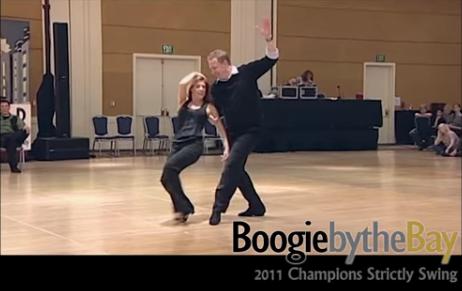
https://youtu.be/bXRC2BiB38w?t=7
Monterey Swingfest 2018, Champions Strictly. Melissa starts out being naughty to Kyle; he gets revenge with wardrobe violence :-) Little bit of comedy.
First place Champions Jack & Jill win with Kyle at recent Monterey Swingfest 2020:
The following dance (Swing Diego 2013) was copyright-blocked for awhile on Youtube. It's great that such fun is back to include here.
First place Jack & Jill win with Kyle at Chico 2009. Gotta like the extra excitement in those smaller venues with mirrored walls. Love that stylistic pause at 3:13:
Featured often in this collection, Ben Morris is a brilliantly creative Lead and is one of many Champions that are currently ubiquitous in the WCS world.
Here are two fine examples of the Rutz magic. Ben is superb in orchestrating the magical opportunities. Just wow!

https://youtu.be/CEhMDU0A5Fs?t=108

https://youtu.be/Ukk0n_hL1Ow?t=6
Just look at the following first place Champions J&J win at Seattle Easter Swing 2016. I saw this live. It has to be text-book flawless. Check out that team arm-work at 1:03--the wind up and the double unwind. Beautifully executed:
Melissa Rutz in top form led by Ben Morris in a first place Champions J&J win at Boogie By the Bay 2022:
Three dances at WCS venue down in Brazil. (~2m each):

https://youtu.be/yEPPvxXVsl0?t=111
With lyrics "You've got the power" don't you love it when Melissa seizes initiative and sets it up for Miles to follow her--reversing the previous pattern where she was led to follow?
Things are sometimes so wild at MADjam. Spoiler: Melissa gives Brent Key a workout so hard that she has to perform CPR on him at the end. Hilarious.
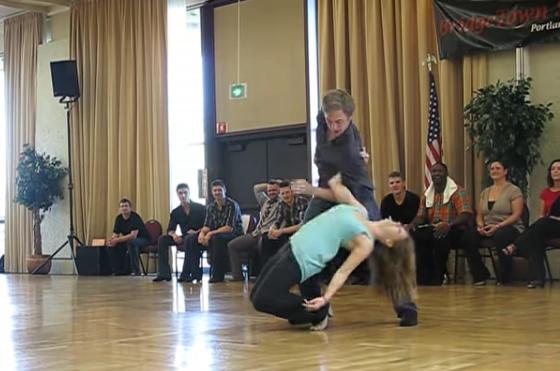
https://youtu.be/OECLc4EtlFA?t=88
Victoria is phenomenal with unique styling that is rich with creative, surprising, and often gymnastic flexibility. Her joyful vitality along with her interpretive synchronization with lyrics is stunningly superb.
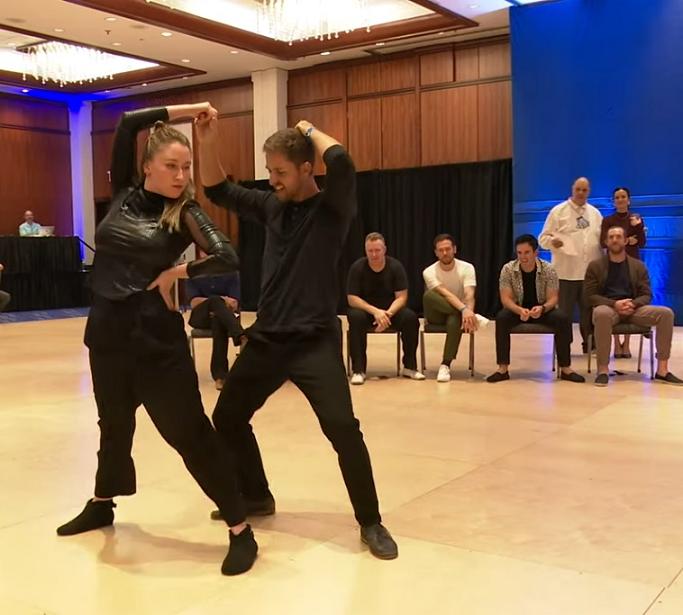
https://youtu.be/dQFijyjUuvE?t=95
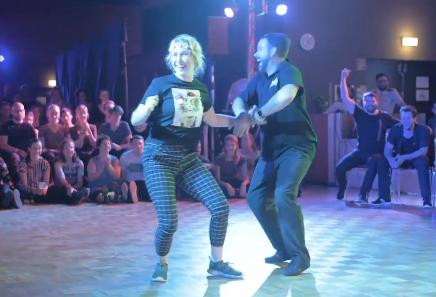
https://youtu.be/4KKtios10gA?t=159
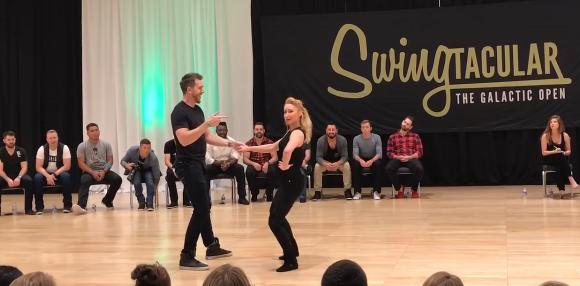
https://youtu.be/t8vtFhI1iow?t=80

https://youtu.be/lJpw-sUFBqA?t=114
Victoria meshes crawl styling with WCS.
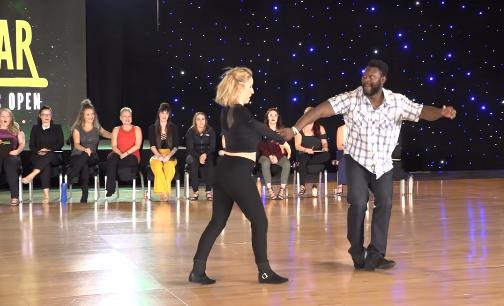
https://youtu.be/bIfbV_Y7hxc?t=133

https://youtu.be/APYT2kYQrVQ?t=138

https://youtu.be/oJM37blnWug?t=95
Torri's speed of interpretive styling is often unbelievable and her styling projects a joyful engagement with both dance and audience that is unique.

https://youtu.be/ZMFviNbFtJI?t=6

https://youtu.be/LAoMg_czTkA?t=27
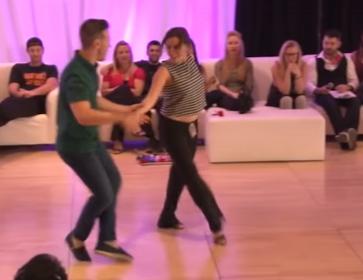
https://youtu.be/U-Ecu1SdYkA?t=208

https://youtu.be/Y74aLinKQkg?t=55

https://youtu.be/v0x-D8LyfEM?t=81
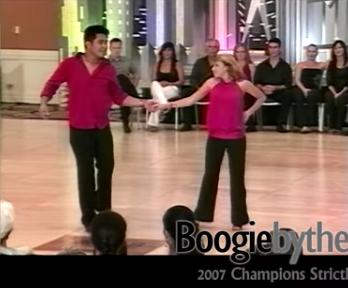
https://youtu.be/1DYxaQPbBnQ?t=6
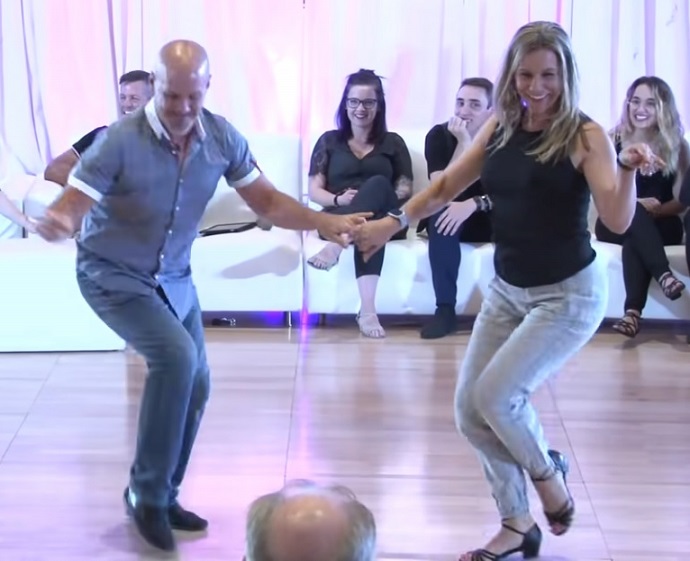
https://youtu.be/F1jE9Gy_plc?t=107

https://youtu.be/GnejSi7sUsE?t=6
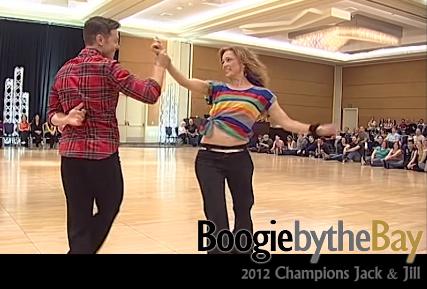
https://youtu.be/KjeIZ61hOP0?t=5

https://youtu.be/FMp22k9U9J8?t=97
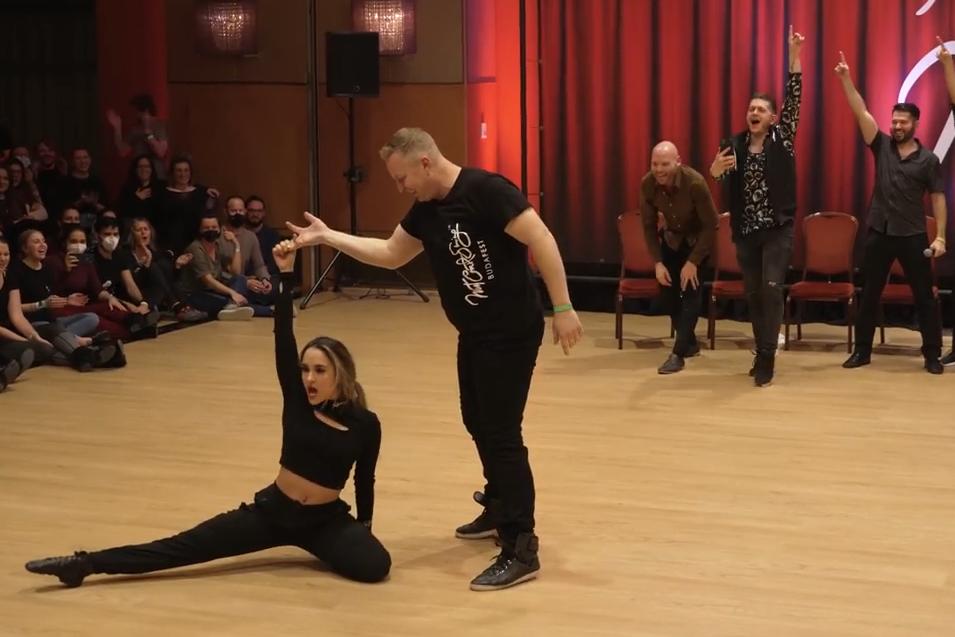
https://youtu.be/Pk2pZTCTleo?t=57
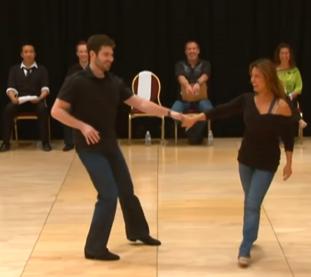
https://youtu.be/YgAmaifXtWA?t=15
Aside from my fascination with West Coast Swing dance both as art form and object of linguistic study, this online tour uses Internet videos that are hyperlinked and selectively cued for commentary in an evolving web-based document. I'm calling this kind of document a "LinkTopic" because it is so richly endowed with embedded links. Of course, there is the risk that, with so many links, some will no longer work when the target is absent for some reason. Over time the content of this linktopic will evolve in its own right if not to fix dead links. Each link has an associated photo-snapshot from the linked video. In each case the explicit URL link is the photo credit. You can click either the photo or the link to view the video. All of these photolinks will launch your browser into a new browser tab. If you have an older browser that doesn't support tabbed windows then a new instance of the browser will likely be launched. When you're viewing within a linked video you can return to this commentary by clicking its tab. That way you can pause the running video and click back and forth between video and associated commentary. This separate tabbed window feature also allows more convenient pause and study of more than one dance at a time--for example, in comparing two dances to the same music (which is featured numerous times in this dance collection).
Most of the photolinks are to videos on Youtube and many of those are cued to a start point within a larger video. As such, most are intended for a usual view time of around 2 minutes each. Youtube doesn't reliably support a coded end time for a video excerpt. When you click a cued link the video will run to its end. So before each link, I'll indicate the number of significant minutes (often mere seconds) intended with a notation like: (~2m). If no time length is indicated then assume an intended view time of about two minutes. Most WCS dance segments in competitions are limited to about two minutes. So unless you get thoroughly hooked like me, don't feel obligated to watch all of each linked video (ie, past the indicated view time). Of course, in Youtube you'll have to click away the advertisements and for some video instances you may have to click the little speaker icon in the video player to get sound. Finally, the video quality varies because many were taken by audience devices including lower resolution cellphones.
This commentary began as I was searching the Internet for the best-of-the-best WCS dances to repeatedly enjoy and to study styling techniques. I made the collection into a convenient list of links each pointing to a video of one of my favorite dances--a separate list I could use on many different computers in different places with Internet access. And then, dangerously, I started to ruminate about what on earth happened to me that got me so hooked :-) That rumination took me into a closer look at WCS in the context of dance in general and into the rather interesting potential of WCS as a watchable performance art in its own right. But, I'll only lightly go into that deeper dimension here except to hint at what I like most in the artistic expression of WCS at its best.
If there is a dominant theme to my commentary it is that, in addition to the great fun of performing WCS on the dance floor, it is eminently watchable as dynamic art on the digital screen. Think of WCS--in video form--as dynamic paintings hanging on the walls of the Internet, each inviting countless re-viewings as art. That's where I'm coming from here. So, with that analogy in mind, the main content here is a tour of my personal art collection.
You'll see the word 'masterpiece' in this commentary but I've tried to restrain from being too gushy with the term. As you've seen, it's hard to curb my enthusiasm. This personal appreciation is more about the art than the technicals of the dance; it's more about art appreciation than art criticism. I've given more weight to artistic interpretive excellence. Such excellence will more often compensate for technical demerits. Needless to say, such a selection process is personally subjective and also heavily biased by my musical taste. The collection is my pick of the best of a thousand or more WCS dances found in the depths of the Internet. Out of the almost 200 dances selected here for special attention, a much smaller subset will be graced with the aforementioned delightful opinions.
There are many hundreds of WCS dances on Youtube and within that universe there are many dimensions that can be focused on for appreciation. I have skewed my selection process here toward an emphasis on the artistry of the Followers. In no way is this meant to diminish the complementary artistry of the Leads. In fact, my choices also honor a selection of the world's best Leads.
The collection is a snapshot window spanning from around 2005 to present. There is always a new crop of outstanding dancers phasing in and contributing to the evolution of WCS. And of course, despite growing hotbeds of WCS world wide, my purview is somewhat skewed by English-speaking and U.S. dance competitions as found on the Internet. Almost all of my selection consists of world-class, champion-level competition dances. So they do reflect the high water mark in the dance and should not disuade you from the noble struggle when you discover how challenging it can be to emulate their artistry at full speed on the dance floor. They are an inspiration as well as an aspiration.
My dance-floor experience with West Coast Swing began around 2003 as the final two (bonus) lessons of a Ballroom Dance Class at a Seattle ballroom (Swedish). I was profoundly captivated because, to me, WCS was so superior to the other ballroom dance forms I was taught. To me there's something that is not directly obvious going on with this art form as it has evolved. West Coast Swing is fun to dance socially, fun as a competitive sport, and fun to watch as art. I wanted to dig almost exclusively into that later artistic dimension in this appreciation commentary. I do not pose here as a WCS professional. I'm simply a devoted fan of the spectacular artistry in this art form.
I hope you enjoyed this online tour of some of the breadth and depth of West Coast Swing with its special focus on Followers. This has been a labor of love and a total joy for me. Even if I'm the only one who uses this web page, it will have been worth it for the sheer convenience of revisiting these favorite works of art. If you've browsed into some of them and been intriqued enough to get into this amazing activity beyond enjoying it on the web, check out West Coast Swing at a dance studio/ballroom venue near you!
Also, if you did enjoy this selective adventure into an artistic appreciation of dance and are curious enough to venture into another area of art appreciation, check out my (growing) Music Favorites linktopic here: Music Favorites
Adam K. Trent (aka KamasDancer)
